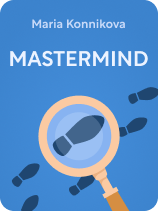

This article is an excerpt from the Shortform book guide to "Mastermind" by Maria Konnikova. Shortform has the world's best summaries and analyses of books you should be reading.
Like this article? Sign up for a free trial here.
Do you find yourself making assumptions only to find out later that you were wrong? What if you approached problems more like Sherlock Holmes?
In Mastermind, Maria Konnikova explores how to not jump to conclusions and instead think more creatively like the famous detective. She offers insights into why we tend to make hasty decisions and assumptions and provides strategies for engaging our imagination to solve problems more effectively.
Read on to discover how you can cultivate Holmes-like thinking and approach challenges with a fresh perspective.
Avoid Jumping to Conclusions
If Sherlock Holmes knows anything at all, he knows how to not jump to conclusions. Instead, he constructs a variety of potential narratives to explain the mystery. How is it that Holmes can conceive multiple possibilities while others on the case either struggle to move past their initial assumptions or fail to propose a single theory? According to Konnikova, he engages in creative thinking, using his imagination to synthesize his knowledge with the evidence he’s observed and to explore patterns and connections between seemingly disparate clues.
Konnikova argues that this imaginative process is vital to Holmes’s investigative success and is also critical for effective decision-making and problem-solving in daily life. We’ll explain how the autopilot mode of thinking inhibits creative problem-solving and how to more consciously engage your imagination.
Autopilot Mode Compels You to Jump to Conclusions
Contrary to Holmes’s imaginative and exploratory approach, operating on autopilot compels you to latch onto the first conclusion or solution that comes to mind. Konnikova explains that just as it predisposes you to cognitive shortcuts, autopilot streamlines your decision-making and problem-solving processes at the expense of thoroughness. This streamlining process nudges you to favor ideas that align with your preconceptions and expectations and to dismiss those that don’t. As a result, you automatically settle for the most obvious or convenient answers and solutions, regardless of their accuracy or effectiveness.
| Three Fallacies Compromise Decision-Making and Problem-Solving Dan and Chip Heath (Decisive) add insight into how autopilot streamlines decision-making and problem-solving by identifying three fallacies that come into play: 1) Binary thinking: You tend to identify and consider only two options, which prevents you from evaluating multiple, potentially better options. For example, you’re unhappy at work and assume you have only two options—quit or stay. 2) Confirmation bias: Once you’ve identified your options, you search for and favor information that underscores your inclinations—and you ignore information that supports your non-preferred option, even if that option is better. For example, because you’re inclined to quit your job, you ignore evidence suggesting that staying might be the most practical choice for now—such as high unemployment rates or upcoming promotions at your current company. 3) Status quo bias: Your natural tendency to favor what’s familiar causes you to resist conclusions that require changing your mind or behaviors. For example, even though you lean toward quitting, you resist entertaining alternatives like freelancing or entrepreneurship because they mark a significant shift from your routine employment. |
How to Consciously Engage Your Imagination to Cultivate Fresh Ideas
Konnikova says that you can override the tendency to make quick decisions, cultivate Holmes’s ability to think outside of the box, and open your mind to new possibilities by practicing six strategies: Challenge your initial assumptions, embrace new ideas and experiences, expand your knowledge, practice mindfulness, engage in constructive distractions, and change your environment.
Strategy 1) Challenge Your Initial Assumptions
Actively seek out contradictory information and perspectives. According to Konnikova, this deliberate search can expose flaws in your initial assumptions and point you toward viable alternatives. For example, if you’re deciding how to reduce operational costs and your first instinct is to cut staff, investigate companies that have achieved cost savings in other ways. (Shortform note: Nassim Nicholas Taleb (The Black Swan) adds that you can’t be sure your assumptions are accurate unless you actively try to disprove them. Taleb uses the term “negative empiricism” to describe seeking out information that could disprove what you think—as opposed to the term “empiricism,” which describes gaining information solely from your observations.)
Strategy 2) Embrace New Ideas and Experiences
Konnikova highlights that exposing yourself to unfamiliar ideas and diversifying your experiences forces your brain to consider a wider range of possibilities, which curbs your tendency to settle for convenient answers. For example, if you’re planning a vacation and automatically think of visiting a popular resort, researching less well-known destinations might lead you to a more adventurous and memorable holiday.
| New Ideas and Experiences Help You Adapt to Different Situations Another advantage of embracing new ideas and experiences is that it helps you adapt to a variety of fields and situations. Dobelli (The Art of Thinking Clearly) explains that when you’re experienced in one field, you naturally develop a rubric—a set of decision-making guidelines or problem-solving strategies—based on this experience. This rubric is an asset when dealing with your field of expertise. However, you tend to apply this rubric when dealing with issues outside your field of expertise, too. This leads you to misinterpret situations or use your experience in unconstructive ways. For example, a lawyer might apply their rigorous analytical approach to a family argument, escalating the situation rather than resolving it. Dobelli suggests that you can overcome this tendency by compensating for areas in which you’re less experienced. For example, the lawyer might learn about emotional intelligence or study conflict resolution techniques. |
Strategy 3) Expand Your Knowledge
Cultivate knowledge across different fields. Konnikova explains that the wider your learning, the easier it is to identify patterns and relationships that are not immediately obvious. For example, your basic knowledge of economic theory may lead you to assume that the only way a business can get more customers is by lowering prices. However, by reading up on social psychology, you might realize that fostering a sense of community can be just as effective.
(Shortform note: Steven Kotler (The Art of Impossible) suggests allocating at least 30 minutes a day to expand your knowledge. Absorbing new information every day feeds your brain a continual stream of information while giving it time to naturally make connections between what you already know and what you’re learning. Meanwhile, Jim Kwik (Limitless) says you’re more likely to expand your knowledge by adopting this three-step process: 1) Before you start a learning session, ask yourself what you specifically intend to learn from it. 2) Keeping your goal in mind, filter the information and write down only what’s relevant to that goal. 3) Once your session is complete, highlight the most valuable information and outline the key points.)
Strategy 4) Practice Mindfulness
Konnikova suggests that mindfulness practices such as meditation enhance creative thinking by detaching your mind from the issue at hand, as well as from other distractions. This creates mental space to consider decisions or problems from a broader, more conceptual standpoint and allows you to explore ideas that might have been obscured by a narrow focus on details. For example, you’ve been grappling with a complex coding problem and feel stuck. After a mindfulness session, you return to the problem with a relaxed mind. This helps you realize that the issue isn’t in the code itself but in the way users are interacting with it, prompting a redesign that resolves the issue and enhances user experience.
| Mindfulness Improves Working Memory Chris Bailey (Hyperfocus), elaborates on how mindfulness creates mental space: It improves your working memory. Bailey explains three key points about working memory: 1) Whenever you focus on a task, it occupies part of your working memory, which holds information your mind is actively processing. 2) The amount of working memory a task occupies depends on its complexity: The more complex a task, the more working memory it requires. 3) Your working memory has a limited capacity in terms of how much information it can hold simultaneously. In other words, your working memory’s capacity determines how much you can pay attention to at any one time. Bailey suggests that mindfulness increases your working memory capacity, enabling you to focus on more complex tasks. Additionally, it improves your ability to make efficient decisions, which increases your productivity: With a higher working memory capacity, you only need to use some of your working memory doing a task. This leaves you with spare working memory to think about that task and plan what you’ll do next. |
Strategy 5) Engage in Constructive Distractions
Take a break from directly focusing on the issue by immersing yourself in an engaging yet undemanding activity. Konnikova notes that this kind of distraction enables your brain to process the problem or decision in the background. This allows your mind to make connections and access ideas that aren’t readily available during intense, focused thought. For example, when putting together a jigsaw puzzle—an activity unrelated to the speech you’re trying to write—you might recall a personal anecdote that perfectly illustrates your main point.
| How Alternating Between Focused and Diffuse Modes Fosters New Ideas Barbara Oakley and Olav Schewe (Learn Like a Pro) clarify how constructive distractions foster new insights and ideas. They explain that your brain has two modes of attention: focused and diffuse. Focused mode is when you deliberately concentrate on a task in front of you—for example, reading or memorizing new information. This mode is best for strengthening your understanding of familiar topics or gaining new knowledge related to things you already know. This is due to two reasons: First, focused mode uses existing neural connections (established pathways in the brain that allow it to efficiently process and recall known information). Second, in this mode, your brain suppresses all thoughts except what you’re purposefully paying attention to, which prevents you from making “aha” connections between different pieces of information. Diffuse mode is when you don’t focus on any one thing in particular but instead let thoughts flow through your mind naturally—like when you’re putting together a jigsaw puzzle. When you’re engaged in such activities, your brain works on problems and processes new information “in the background” by making novel connections (building new neural connections) between ideas and knowledge that it cannot make while in focused mode. Oakley and Schewe suggest that alternating between both modes optimizes your ability to generate and apply new insights and ideas: Focused mode helps you comprehend the task at hand, taking a mental break in diffuse mode allows your brain to discover new insights, and switching back into focused mode allows you to apply those insights to the task. |
Strategy 6) Change Your Environment
Switch up the environment where you usually address the decision or problem you’re facing—for instance, by relocating to a new room or going for a walk. Konnikova notes that new surroundings offer varied sensory experiences that nudge your brain to think differently. For example, if you’re suffering from writer’s block, moving from your usual workspace to a bustling café might surround you with a lively atmosphere, sparking a flow of fresh phrases and concepts that rejuvenate your writing.
(Shortform note: Barbara Oakley (A Mind for Numbers) clarifies how changing your environment helps you think differently. When you habitually address a task in the same place, your brain tends to make neural connections between that task and that place—meaning that your brain associates your thinking patterns for the task with that specific environment. However, when you work on the task in a different setting, your brain retrieves the information you need using slightly different neural pathways, allowing you to see that information from alternative perspectives.)

———End of Preview———
Like what you just read? Read the rest of the world's best book summary and analysis of Maria Konnikova's "Mastermind" at Shortform.
Here's what you'll find in our full Mastermind summary:
- The specific mental strategies Sherlock Holmes uses to unravel mysteries
- Why most people don’t think like Sherlock Holmes
- How to improve your memory, sharpen your observation skills, and think more rationally






